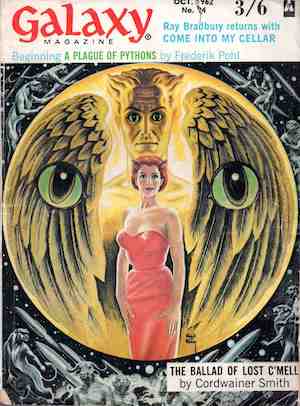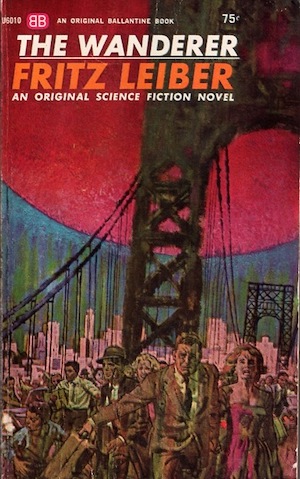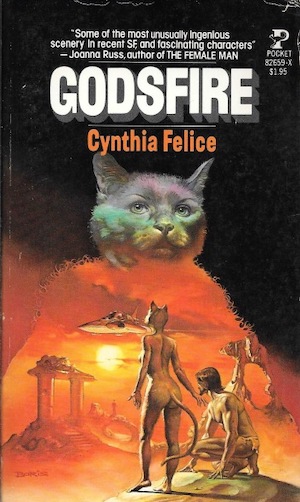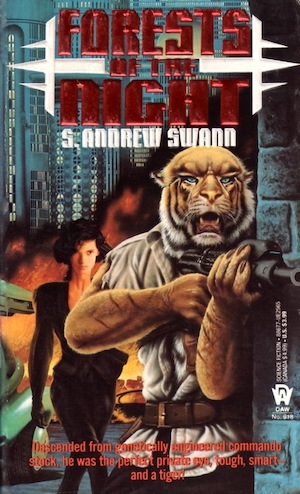All across Earth there are billions of people who adore cats. At the same time, there are some people who can only grudgingly tolerate other humans. Imagine if one could somehow combine the best aspects of humanity—thumbs, can openers—with the grace1, style, glorious fur, and sociopathy of cats. What wonders might we see?
A considerable number of science fiction authors2, presumably all uncompensated servants to their furry masters cat fanciers, have attempted to answer that question. Here are five vintage answers…
The Ballad of Lost C’Mell by Cordwainer Smith (1962)

(Originally published in Galaxy Magazine, later collected in The Best of Cordwainer Smith) The Instrumentality of Man solved the servant problem with Underpeople: animals transformed into humanoid shape, given human-level intelligence, enslaved, and denied any semblance of human rights. Subject to draconian laws, Underpeople serve until they die3. Everyone wins! Or at least the humans do.
Unsurprisingly, Underpeople like the catgirl C’mell yearn for freedom. More surprisingly, some humans are sympathetic to their plight. Lord Jestocost is one such. Apart, neither C’mell nor Lord Jestocost are likely to significantly advance the cause of the Underpeople. Together, however…
While many of the means by which the Underpeople have been kept enslaved are quite familiar, the Lords of the Instrumentality have one novel twist, which is that the process used to transform animals into Underpeople does not produce heritable changes. Without access to that biotechnological tweak, Underpeople cannot produce more Underpeople and would quickly go extinct.
The Wanderer by Fritz Leiber (1964)

Foreshadowing Disco Era disaster films, a diverse cast of characters find their lives upended by calamity. The human race is imperiled by “The Wanderer,” a planet-sized starship filled with sexy bohemian catgirls4 who want to dismantle and steal the Earth’s moon. The Wanderer is massive enough for its tidal forces to shred the moon. The effect on Earth is reduced by distance, but still calamitous.
Alien catgirl Tigerishka takes the time to explain what’s going on. The beings who call the Wanderer home are free-thinking sexy beasts who totally reject conformity, man. Buzzkill galactic squares want to harsh the wanderers’ joie de vivre. The Wanderer needs to refuel and flee before the cosmic fuzz shows up. If a few billion hairless apes are collateral damage, well, freedom has its price.
However awesome “a planet-sized starship filled with sexy bohemian catgirls who want to dismantle and steal the Earth’s moon” sounds, the reality of the actual novel is far more dismal. There are cool ideas here, none of them executed particularly well5. Perhaps some young author will want to riff on this notion.
Godsfire by Cynthia Felice (1978)

Although Heao’s pre-scientific cat people would not think in such terms, living in the shadowed region under their world’s Saturn-like rings means that they are denied a clear view of Godsfire, as they call their sun. The King-conqueror has nightmares about Godsfire. To better comprehend the sun, an expedition must be dispatched out of the twilit realm into the fully illuminated regions. Scholar Heao is part of the expedition.
Heao and her kin discover that the sunlit regions are already populated, not by fellow cat people, but by cousins to the hairless human slaves who serve Heao’s people. These humans enjoy a vast technological advantage over Heao’s people. The off-worlders do not approve of their cousins’ plight. Among the tools available to express human displeasure? Weapons very much like the Godsfire that haunts the King-conqueror’s nightmares.
Godsfire is an example of another subgenre of SF: stories told from the alien perspective. Identifying with the cat people may be distressing to some readers, as it’s pretty clear that humans refuse to engage in peaceful co-existence with technologically disadvantaged non-humans.
The book ends before the ramifications of this refusal are fully explored.
Breed to Come by Andre Norton (1972)

The Demons created Furtig’s feline people, as well as the porcine Tuskers, the ratlike Rattons, and the canine Barkers—all transformations of what were considered mere animals.
The Demons were smarter than they were wise and exterminated themselves. The world is now the domain of the four kinds.
Young Furtig wishes only to prove himself to Those Who Choose, the breeding-age cat-women of his tribe. Fate is unkind to Furtig. Not only is he not a match for his rivals, more calamitous challenges loom. The Demons did not all die. Some fled to another star system. Now, a starship full of Demons have returned to their long-lost home planet, Earth, a world they very much regard as theirs, no matter what some uplifted animals might think.
Breed to Come parallels in some respects Jack Kirby’s comic Kamandi. While Kamandi was clearly influenced by The Planet of the Apes6, I suspect that Norton’s primary influence was that she really liked cats. Breed to Come and Kamandi appeared almost simultaneously, yet another example of two authors simultaneously appearing at similar destinations via dissimilar routes.
Forests of the Night by S. Andrew Swann (1993)

Created as expendable soldiers during the Pan-Asian War, the human-animal hybrids dubbed Moreaus are one of America’s grudgingly tolerated minorities. The baseline human majority graciously permits Moreaus to eke out livings in designated ghettos… at least until legislation can be passed to deport or sterilize the Moreaus.
Pantherian Nohar Rajasthan is a private detective in decidedly unglamorous Cleveland. Prudence dictates a low profile. Nevertheless, Nohar agrees to investigate a murder to which the police seem oddly indifferent. The clues lead to a global conspiracy responsible for Earth’s crapsack status. Knowing too much means that Nohar’s already dismal probable lifespan is now much, much shorter.
It’s depressing how many of these books feature cat people created for various untoward purposes, rather than because cat people would be awesome. The moral appears to be “humans are jerks”7. In this work, there are a few mitigating circumstances.
These are just a few examples of the subgenre and not recent ones at that. Many of you likely have your own favorites. Feel free to mention them in comments below.
- The writing of this article was punctuated by the thud of a cat rolling into the gap between the sideboard and the wall. If it could speak, I am sure it would tell me that it did this on purpose. ↩︎
- It’s not just SF authors writing about cat people, of course, but if I were to list all the manga examples, we’d be here until the end of the century. ↩︎
- No doubt if there were an afterlife and if the Instrumentality could access it, they would compel the shades of the Underpeople to continue slaving away. ↩︎
- Not just catgirls. There are other flavors of humanoids. ↩︎
- As you know, The Wanderer won the Best Novel Hugo. How, you ask? Well, it was a weak year. The other novels on the ballot were Pangborn’s Davy, Smith’s The Planet Buyer, and Brunner’s The Whole Man. While Davy was a strong contender, one could argue that neither the Smith nor the Brunner were quite Hugo-level. Also, the voting pool was miniscule: Wanderer won with 52 votes to Davy’s 48 to The Planet Buyer’s 34 to The Whole Man’s 26. Small voting pools can easily produce odd results (ask me about juried awards). However, what I think got The Wanderer that four-vote edge over the superior Davy was Leiber’s absolutely shameless sucking up to fans throughout his novel. ↩︎
- Kirby was influenced by DC Comics editor Carmine Infantino’s request that Kirby to create a comic similar to Planet of the Apes without (quite) infringing on The Planet of the Apes IP, which Marvel Comics owned. ↩︎
- An exception to this generalization would be the Leiber novel. I suppose that its moral is “this counterculture is rich with hot but off-handedly deadly sociopaths.” That seems a little harsh. ↩︎










